What is a class 2 mobility scooter?
Just what is a class 2 mobility scooter?
The answer to what makes a mobility scooter a class 2 is dependent on a number of factors and they must meet or exceed certain requirements as defined by the law surrounding their specifications and use.
Firstly, they do not require any kind lighting package or reflectors and this is the first area in which all of our Quingo class 2 mobility scooters exceed the specification required by law.
Because your safety is paramount to us all of the three class 2 mobility scooter models in our range, the Ultra, Flyte and Classic feature comprehensive lighting packages.

Unlike a class 3 mobility scooter you don’t need to register a class 2 scooter – your mobility scooter or powered wheelchair is not required to be a registered vehicle. However, most mobility scooters and wheelchairs will already be registered by the supplier or producer before you purchase them.
All mobility scooters and powered wheelchairs can lawfully travel at a maximum of 4mph on footpaths, pavements or in pedestrian areas. A class 3 scooter, unlike a class 2 mobility scooter, is required to feature a switching device that limits the scooter to 4mph for use in areas designated for pedestrian use.
A class 2 mobility scooter may not be used on the road apart from where reasonable use is essential, such as crossing roads, circumventing blockages to your access to the pavement like skips or inconsiderately parked vehicles.
You cannot drive any type of mobility scooter or powered wheelchair on cycle paths marked ‘Cycle Only’.
You can only drive on the road in a class 3 mobility scooter with a maximum speed of 8mph.
All regular parking restrictions apply to mobility scooters and powered, electric wheelchairs.
Your vehicle should not be left on a footpath or pedestrian area on its own if it restricts access for other pedestrians, including other scooter and wheelchair users and people with prams, pushchairs or shopping carts.
There is no legal eyesight requirement to drive mobility scooters or powered wheelchairs, but you should be able to read a car’s registration number from a distance of 12.3 metres (40 feet).
You must check that you can still do this regularly.
You can only drive a mobility scooter or powered wheelchair if you have difficulty walking due to an injury, physical disability or other medical condition.
Are demonstrating the vehicle before it’s sold, such as during our highly regarded free home demonstrations, or are training a disabled user like our ROSPA compliant Blue Diamond Driver Check training course.
Your carer can drive the mobility scooter to or from maintenance or repair but, being as we offer you home servicing of your Quingo this will not be necessary.
You can drive a class 2 mobility scooter under the age of 14 but you must be older than 14 to drive a class 3 scooter.
Insurance is not a legal requirement for the use of a mobility scooter or powered wheelchair.
That said, we highly recommend you to take some out and will offer you’re a very comprehensive and great value for money package from our partners First Senior when you purchase one of our scooters.
The peace of mind of having insurance is automatically included with our contract hire deals.
We hope we have given you a clear explanation as to the question “what is a class 2 mobility scooter?” in this article.
If you need further clarification or feel you need to find out if this is the right type of scooter for you please call us free on 0808 100 6570 to organize a free test drive or just to ask our dedicated team further questions.
